
Ivan Konstantinovich Aivazovsky stands as a monumental figure in the history of Russian art, celebrated universally as one of the greatest marine painters of the 19th century. Born into a period of burgeoning national identity and artistic exploration, Aivazovsky dedicated his prolific career almost exclusively to capturing the infinite moods of the sea. His work, deeply rooted in the Romantic tradition yet infused with a striking realism, continues to captivate audiences with its dramatic power, technical brilliance, and profound emotional resonance. Over a long and immensely productive life, he created an astonishing legacy that cemented his place not only within Russian culture but on the international stage.
Humble Beginnings and Artistic Awakening
Ivan Aivazovsky (born Hovhannes Aivazian) entered the world on July 29, 1817, in the Crimean port town of Feodosia. His family was of Armenian descent, merchants who had settled in this vibrant Black Sea community. Despite the family facing financial hardship, young Ivan's artistic talents were evident from an early age. His innate ability to capture the world around him, particularly the ever-present sea visible from his hometown, did not go unnoticed. Recognizing his potential, local patrons supported his initial education.
His formal artistic journey began at the Simferopol Gymnasium, but his exceptional promise soon earned him a scholarship to the prestigious Imperial Academy of Arts in St. Petersburg. This move was pivotal, placing him at the heart of Russia's artistic establishment. At the Academy, he studied landscape painting, initially under Maxim Vorobiev, a respected painter known for his cityscapes and atmospheric scenes. Vorobiev's emphasis on perspective and light likely provided a solid foundation for the young artist.
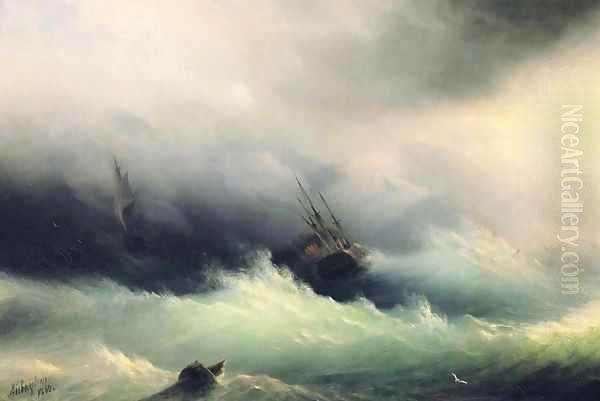
Aivazovsky quickly distinguished himself, absorbing the lessons of his teachers while developing his unique fascination with the marine environment. He also benefited from the tutelage of the French marine painter Philippe Tanneur, who was working in Russia at the time. Although their relationship was reportedly strained, the exposure to a European approach to seascapes may have broadened Aivazovsky's perspective. Furthermore, the influence of Sylvester Shchedrin, another prominent Russian painter celebrated for his Italian landscapes and sensitive handling of light, can be discerned in Aivazovsky's early attempts to capture natural effects.
The Grand Tour: Europe and the Shaping of a Vision
Graduating from the Academy with honors and a gold medal, Aivazovsky earned the right to travel abroad for further study, a common practice for promising Russian artists. From 1840 to 1844, he embarked on an extensive tour of Europe, a period that proved immensely formative. He spent considerable time in Italy, particularly in Rome, Venice, and Naples, cities whose light, history, and coastal beauty deeply inspired him. The Italian landscape, with its dramatic coastlines and luminous atmosphere, provided fertile ground for his developing style.
In Rome, he immersed himself in the classical tradition and interacted with the vibrant community of Russian artists and writers living there, including the famed author Nikolai Gogol, with whom he formed a friendship. His paintings from this period, often depicting Italian coastal scenes, began to attract significant attention. His work was praised for its technical skill and its ability to convey the power and beauty of the sea. Notably, Pope Gregory XVI was so impressed by Aivazovsky's painting "Chaos" that he acquired it for the Vatican Museums, a remarkable honor for a young, non-Catholic artist.
Perhaps the most significant European influence Aivazovsky encountered was the work of the British master J.M.W. Turner. While it's debated whether they ever met, Aivazovsky undoubtedly saw Turner's paintings during his travels, possibly in England or through exhibitions elsewhere. Turner's revolutionary approach to light, color, and atmosphere, particularly in his turbulent seascapes, resonated deeply with Aivazovsky. The Englishman's ability to dissolve form into light and capture the sublime, elemental power of nature left an indelible mark on the Russian painter's own treatment of light on water and dramatic weather effects. He also admired the work of French landscape and marine painters like Claude Lorrain, known for his idealized landscapes and mastery of light, and Claude Joseph Vernet, celebrated for his dramatic shipwrecks and coastal views.
Return to Russia: Appointment and Acclaim
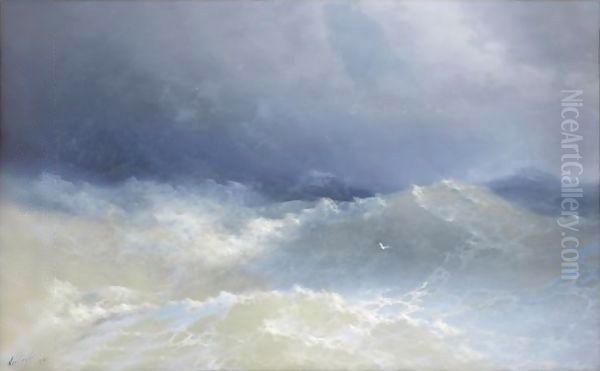
Aivazovsky returned to Russia in 1844 as a celebrated artist. His European successes had preceded him, and he was quickly embraced by the Russian establishment. He was appointed the official painter of the Russian Navy, a prestigious position that granted him access to naval maneuvers, ports, and ships, further fueling his primary subject matter. This role also allowed him to travel extensively with the fleet, witnessing firsthand the sea in all its conditions, from the Baltic to the Black Sea and beyond.
His connection with the Navy provided him with opportunities to depict specific historical events and naval battles, contributing to a genre that celebrated Russian maritime power and history. These works often combined his skill in rendering the sea and ships with a patriotic narrative, resonating with the nationalistic sentiments of the era. He was also made an Academician of the St. Petersburg Academy of Arts, and later a Professor, although his teaching activities were less extensive than his painting output.
His fame grew exponentially. Exhibitions of his work drew large crowds, captivated by his ability to render the sea with unparalleled realism and emotional depth. He became one of the most popular and commercially successful artists in Russia, his paintings sought after by the Imperial family, aristocracy, and wealthy patrons. His St. Petersburg studio became a hub, though he increasingly felt the pull of his Crimean homeland.
The Soul of the Sea: Aivazovsky's Artistic Style
Aivazovsky's style is a unique synthesis of Romanticism and Realism. From Romanticism, he drew his love for the dramatic, the sublime, and the emotional power of nature. His paintings often depict nature at its most untamed – furious storms, towering waves, shipwrecks battling the elements – evoking feelings of awe, terror, and human insignificance before the might of the sea. The dramatic play of light and shadow, the heightened emotional atmosphere, and the focus on nature's overwhelming power are hallmarks of the Romantic sensibility. He shared this affinity for the dramatic aspects of nature with other European Romantics like Caspar David Friedrich, though Aivazovsky's focus remained steadfastly marine.

Yet, Aivazovsky grounded his Romantic vision in meticulous observation and a remarkable degree of realism. His knowledge of the sea was profound, built on lifelong observation. He possessed an extraordinary visual memory, famously preferring to paint in his studio rather than en plein air. He argued that the rapid movement of the elements could not be captured directly from nature but had to be reconstructed from memory, allowing the artist to convey the essence rather than just the fleeting appearance. This method allowed him to achieve astonishingly convincing depictions of water's transparency, the texture of foam, the reflection of light on wet surfaces, and the complex dynamics of waves.
His technique was equally distinctive. He often employed a method similar to alla prima, working quickly and directly, sometimes completing large canvases in a matter of days or even hours. He frequently started with a white or lightly toned ground, allowing him to build up layers of transparent and semi-transparent glazes. This technique contributed to the luminosity of his paintings, particularly his famous depictions of moonlight on water or sunlight breaking through storm clouds. His "transparent foam wave" technique became legendary, capturing the ephemeral quality of breaking waves with dazzling skill. The German marine painter Andreas Achenbach, known for his realistic seascapes, provides an interesting contemporary comparison in terms of technical focus, though Aivazovsky's work often carried a greater Romantic charge. Similarly, the French painter Eugène Isabey explored dramatic coastal scenes, but Aivazovsky's sheer volume and focus on the open sea set him apart.
Masterworks: Capturing the Ocean's Many Moods
Throughout his long career, Aivazovsky produced an estimated 6,000 paintings. While quality inevitably varied across such a vast output, his oeuvre includes numerous masterpieces that define his legacy. His subjects ranged from tranquil moonlit nights and calm coastal vistas to epic naval battles and terrifying tempests.
Perhaps his most famous work is The Ninth Wave (1850). This painting depicts a group of shipwreck survivors clinging to debris amidst a tumultuous sea after a nighttime storm. The sun rises, illuminating gigantic, translucent waves – the mythical "ninth wave" being considered the deadliest. Despite the peril, the warm light offers a glimmer of hope, showcasing Aivazovsky's ability to blend terror and beauty, despair and resilience. The painting became an icon of Russian art, celebrated for its technical virtuosity and emotional power.
Another major work, The Black Sea (1881), presents a different mood. It depicts a brewing storm over a dark, choppy sea. There is a sense of foreboding and raw, untamed nature. The painting is noted for its dramatic simplicity and its focus purely on the elemental forces of water and sky, largely devoid of human narrative. It demonstrates his mastery of conveying atmosphere and the immense scale of the ocean.
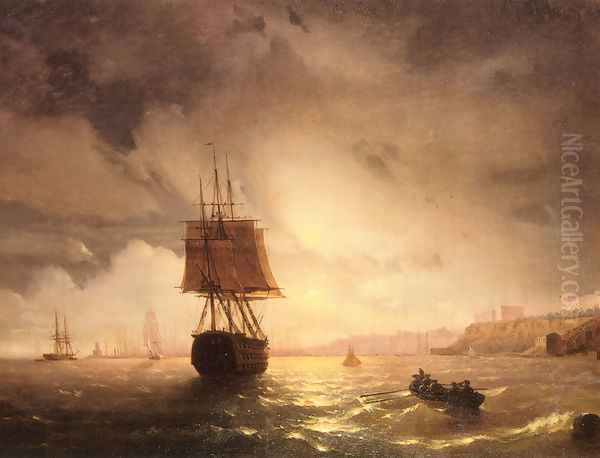
Aivazovsky frequently returned to the theme of naval battles, celebrating Russian maritime history. Paintings like The Battle of Chesma at Night (1848) and The Battle of Sinop (1853) are dramatic, fiery spectacles, showcasing his skill in depicting smoke, fire, and complex compositions involving numerous ships, all set against the backdrop of the sea. These works resonated with national pride and were highly regarded by his patrons, including Tsar Nicholas I. He stood alongside other great Russian history painters of his time, such as Karl Bryullov (The Last Day of Pompeii) and Alexander Ivanov (The Appearance of Christ Before the People), though Aivazovsky applied his historical focus primarily to the maritime sphere.
His repertoire also included numerous paintings capturing calmer moments: serene sunsets over the water, moonlit nights reflecting on gentle waves (Moonlit Night on the Bay of Naples, 1840s), and tranquil coastal scenes (Calm Sea, 1863). Works like Ox-Cart Convoy (or The Wagon Train, 1860s) show his versatility, depicting scenes of Crimean life against a coastal backdrop. He also painted storms with terrifying intensity, such as Ship in a Storm (1887) and Wave (often identified as Among the Waves, 1898), one of his later, powerful depictions of a single, immense wave dominating the canvas.
Feodosia: Homecoming and Philanthropy
Despite his international fame and connections in St. Petersburg, Aivazovsky remained deeply attached to his hometown of Feodosia. In 1845, he decided to build a house and studio there, overlooking the Black Sea that had inspired him since childhood. He would spend the majority of his later life in Feodosia, making it his permanent base while still traveling for exhibitions and commissions.
His connection to Feodosia extended beyond mere residency; he became a major benefactor to the city. Using the considerable wealth generated by his art, he funded numerous civic projects. He established an art school, fostering local talent. In 1880, he opened an art gallery attached to his house, making his own extensive collection accessible to the public. This gallery became one of the earliest provincial museums in the Russian Empire and remains a major cultural institution today, known as the Aivazovsky National Art Gallery.
His philanthropy touched many aspects of Feodosian life. He played a crucial role in bringing a reliable water supply to the drought-prone city, funding a pipeline from a spring on his estate. He contributed to the construction of the local railway line, improving connectivity. He was also passionate about archaeology, conducting numerous excavations in the vicinity of Feodosia, uncovering ancient Greek sites and artifacts, many of which he donated to the Hermitage Museum in St. Petersburg. His dedication transformed Feodosia into a significant cultural center.
Personal Life and Character
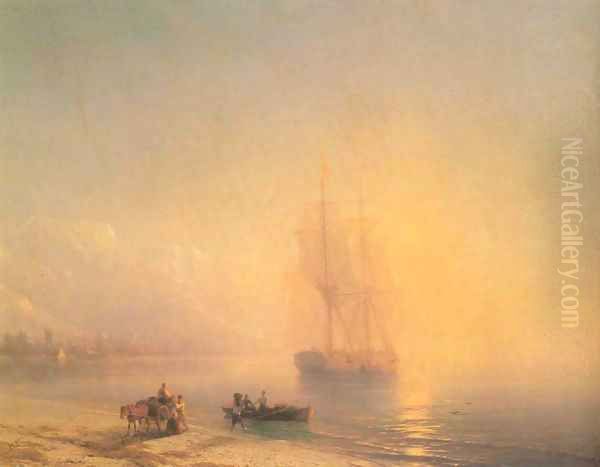
Aivazovsky's personal life had its complexities. His first marriage, to Julia Graves, an English governess, produced four daughters but ultimately ended in a difficult divorce in 1877, reportedly due to scandal surrounding Julia. He later remarried Anna Burnazian, a young Armenian widow from Feodosia, in 1882. This second marriage appears to have been happier. Some accounts suggest that the emotional turmoil of his first marriage influenced some of his more dramatic paintings, adding a layer of personal feeling to the depicted storms.
He was known for his incredible energy and work ethic, capable of painting for hours on end with remarkable speed and concentration. Anecdotes abound about his ability to create complex scenes entirely from memory. He was also musically inclined and maintained friendships with figures from across the arts, including the composer Mikhail Glinka. It is said that Aivazovsky provided Glinka with Tatar folk melodies that the composer later incorporated into his opera Ruslan and Lyudmila. This highlights Aivazovsky's broad cultural interests beyond painting.
His Armenian heritage remained important to him throughout his life. He supported Armenian causes and occasionally depicted Armenian historical or landscape themes. His international success brought pride to the Armenian community, both within the Russian Empire and abroad.
Later Years and Enduring Legacy
Aivazovsky continued to paint with undiminished energy well into his old age. His later works, such as Among the Waves (1898), show a continued fascination with the raw power of the sea, sometimes becoming almost abstract in their focus on water and light. He remained a revered figure, celebrated with numerous exhibitions and honors during his lifetime.
He passed away in his home in Feodosia on May 2 (O.S. April 19), 1900, reportedly while working on a painting titled The Explosion of the Turkish Ship. His death marked the end of an era in Russian art. He left behind an unparalleled body of work dedicated to the sea, influencing subsequent generations of Russian artists. While direct stylistic followers were few, his mastery of light influenced landscape painters like Arkhip Kuindzhi, known for his dramatic light effects. The emotional depth he brought to landscape perhaps finds echoes in the work of Isaac Levitan, the master of the "mood landscape," although Levitan's subjects were typically inland Russian scenes. Even realist masters like Ilya Repin and Vasily Surikov, though focused on different genres, worked within the same vibrant 19th-century Russian art scene that Aivazovsky dominated in his specific field.
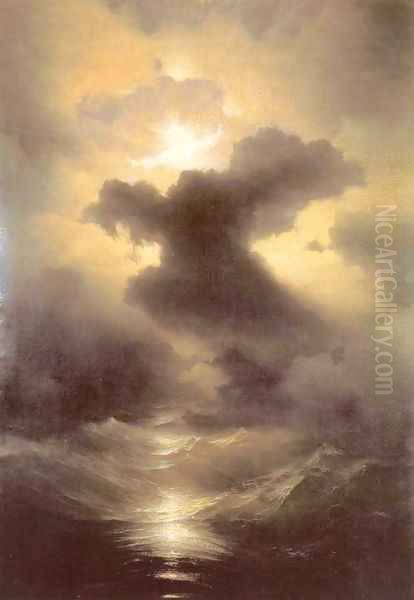
Today, Ivan Aivazovsky is remembered as the undisputed master of the marine genre in Russian art. His paintings are treasured in museums across Russia, Ukraine, Armenia, and worldwide, including the State Russian Museum in St. Petersburg, the Tretyakov Gallery in Moscow, and his own gallery in Feodosia. His ability to capture the sea's terrifying power and its serene beauty, blending Romantic drama with realistic detail, ensures his enduring appeal. He was more than just a painter of seas; he was a poet of the ocean, translating its infinite variations into a visual language that continues to speak powerfully to viewers more than a century after his death. His life and work remain a testament to artistic dedication, technical brilliance, and a profound, lifelong connection to the natural world.